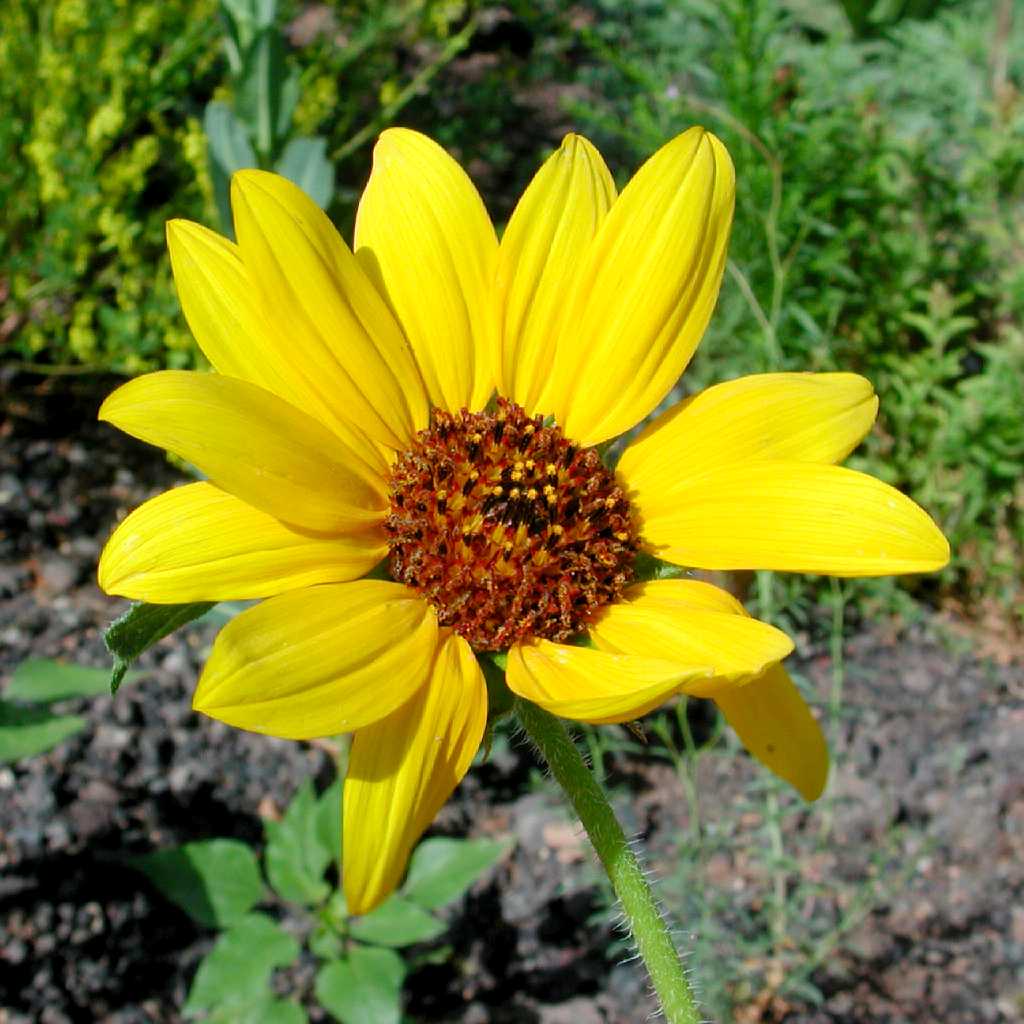Helianthus
|
Family: Asteraceae |
Annuals or perennials, (5-)20-300(-500) cm. Stems erect or ascending to decumbent or pro-cumbent, usually branched distally. Leaves basal and/or cauline; opposite, or opposite (proximal) and alternate, or alternate; petiolate or sessile; blades usually 3-nerved (1-nerved in H. eggertii, H. smithii, and H. maximiliani), mostly deltate, lance-linear, lanceolate, lance-ovate, linear, or ovate, bases cordate to narrowly cuneate, margins usually entire or serrate, rarely lobed, faces glabrous or hairy, often gland-dotted. Heads usually radiate (sometimes discoid in H. radula), borne singly or in ± corymbiform, paniculiform, or spiciform arrays. Involucres usually ± hemispheric, sometimes campanulate or cylindric, 5-40+(-200+ in cultivars) mm diam. Phyllaries persistent, 11-40(-100+ in cultivars) in 2-3+ series (subequal to unequal). Receptacles flat to slightly convex (conic in H. porteri), paleate (paleae ± conduplicate, usually rectangular-oblong, usually ± 3-toothed, sometimes entire, apices sometimes reddish or purplish). Ray florets usually 5-30+(-100+ in cultivars), rarely 0, neuter; corollas usually yellow. Disc florets (15-)30-150+(-1000+ in cultivars), bisexual, fertile; corollas yellow or reddish (at least distally), tubes shorter than campanulate throats, lobes 5, triangular (style branches slender, appendages ± attenuate). Cypselae (usually purplish black, sometimes mottled) ± obpyramidal, ± compressed (glabrous, glabrate, or ± hairy); pappi 0 (H. porteri), or readily falling, of 2(-3) usually lanceolate, aristate, or erose scales (at the 2 principal angles, 1-5 mm) plus 0-8 usually shorter scales (0.2-2 mm). x = 17. The identification of sunflower species has long been problematic. C. B. Heiser et al. (1969) felt that the greatest contribution of their sustained efforts to understand sunflower taxonomy was not providing an easy way to identify sunflowers but rather an explanation for why they are so difficult. Taxonomic difficulties are based on a combination of factors, notably developmental and ecologic plasticity, the frequency of interspecific hybridization, and the presence of polyploidy. L. H. Rieseberg (1991) and Rieseberg et al. (1988, 1990) have subsequently documented the presence of species of homoploid hybrid origin to add to the complexity. The keys in this treatment have been modified somewhat with observations of features that require microscopic observation, such as the distribution of glands (sometimes referred to as 'resin dots') and the color of anther appendages; they still are based heavily on those of Heiser et al. There will still be specimens, of hybrid origin or growing in unusual conditions or incompletely collected, that defy certain placement into a single species. The taxonomic rank of certain taxa is also problematic, and for the most part the treatment of Heiser et al. has been followed, with relatively few exceptions. With the exception of Helianthus ×laetiflorus, which is widespread and commonly encountered away from either parental species, hybrids are not treated as separate entities. Helianthus verticillatus has been verified as a distinct entity, unlikely to be simply a hybrid. Whether H. praetermissus E. Watson, which continues to be known only from a single fragmentary specimen, represents a distinct species or an anomalous collection is still uncertain; it has not been included here.
Heads radiate, the rays large, yellow, neutral; invol bracts subequal to imbricate, usually green; receptacle flat to low-conic, chaffy, its bracts clasping the achenes; disk-fls perfect and fertile; style-branches flattened, hispidulous on both sides (at least distally), the stigmatic lines poorly developed; achenes thick, moderately compressed at right angles to the invol bracts, glabrous or sometimes hairy; pappus of 2 readily deciduous awns with enlarged, thin, paleaceous base, rarely with some additional short scales; coarse annual or more often perennial herbs with simple lvs, at least the lowermost ones opposite; x=17. 50, N. Amer. Hybrids abound. Gleason, Henry A. & Cronquist, Arthur J. 1991. Manual of vascular plants of northeastern United States and adjacent Canada. lxxv + 910 pp. ©The New York Botanical Garden. All rights reserved. Used by permission. |

